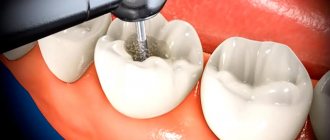05.11.2019
The time frame for swelling of the cheek to go away after dental treatment depends on the degree of tissue injury. Swelling is caused by damage to blood vessels, ligaments and soft tissues during therapeutic or surgical interventions. It can be removed with cold compresses, anti-inflammatory drugs, and rinses. At the same time as these measures, a consultation with a doctor is required - only he will be able to distinguish a normal reaction from a complication.
Why does swelling occur after surgery?
Most often, swelling of the cheek occurs after tooth extraction, implantation, or any interventions accompanied by excision of the mucous membrane. It is provoked by both standard, considered normal, causes, and pathological factors.
Swelling is considered normal if it appears after:
- Complicated extraction. This includes swelling of the cheek after the removal of wisdom teeth, impacted or dystopic units. Such operations are accompanied by sawing of the bone, incisions of the mucous membrane, and severe damage to structures. Swelling of the tissues surrounding the tooth provokes facial asymmetry, difficulty opening the mouth, talking, and chewing.
- Removal due to inflammatory processes. The situation arises when an infection has developed in the tooth canals and at the root apex for a long time, which has led to pulpitis, periodontitis, cysts, granulomas, abscesses, and periostitis. Despite antiseptic treatment of the hole and taking antibiotics, it is impossible to immediately completely get rid of pathogenic microorganisms.
- Incisions on the gum. When there is a cavity with exudate in the soft tissue, an incision is made to remove the formation and release the pus. If there was already swelling, it may increase in the first couple of days.
- Installation of dental implants. Swelling of the cheek after tooth implantation is considered normal, as the integrity of the ligaments, soft and bone structures is damaged.
Additional Information! In a certain group of patients, swelling is considered the body's standard reaction to intervention. These include people with a large amount of subcutaneous fat, suffering from diabetes and hypertension.
Swelling is considered a complication if it occurs against the background of:
- "Dry socket." This is the name of the condition when a blood clot falls out of the socket, preventing the entry of microbes. In this case, the infection penetrates inside, inflammation develops, and pain appears.
- Alveolitis. The disease is accompanied by suppuration of the socket, bad breath, general intoxication, and severe pain. Develops due to the prolapse of a blood clot and the use of unsterile surgical instruments. It is characterized by the appearance of swelling on the third day.
- Hematomas. It occurs due to damage to soft tissue. It is not dangerous in itself and goes away on the second day. But if an infection occurs, the tissues become inflamed, pus accumulates, an unpleasant odor and high temperature are noted.
Clinical picture
A clear sign of gumboil is a lump on the gum with purulent contents. Before its formation, the disease makes itself felt by throbbing pain in the tooth. Symptoms of the pathology are also:
- swelling and redness of the gums,
- swelling of the cheek or lip,
- enlarged lymph nodes,
- pain when opening the mouth and swallowing,
- discomfort when pressing on a tooth,
- increase in body temperature,
- excessive weakness
- decreased appetite.
If you detect at least one of the listed signs of flux, you should contact the dentist. You should not warm the sore spot with a warm compress, take antibiotics without a doctor’s prescription, or open an abscess at home.
Causes of swelling after therapeutic treatment
Much less often than during operations, swelling of the cheek occurs after therapeutic treatment of a tooth. The situation is due to the following reasons:
- Incorrect anesthesia. Swelling is possible if the patient is allergic to a certain medication or the doctor hit the vessel with a needle. In the first case, the gums will turn red, a rash and shortness of breath will appear. In the second, the mucous membrane will acquire a bluish tint. Most often, damage occurs during conduction anesthesia performed with outdated instruments rather than carpule syringes.
- Poor quality endodontic treatment. The cause of swelling of the cheek is an incompletely removed nerve, poorly disinfected or incompletely passed canals, or removal of the filling material beyond the apex (apex of the root). In 99% of cases, an inflammatory process will develop. It will lead to the formation of granulomas and cysts.
- Hypersensitivity. Allergic reactions can develop to antiseptics, filling materials or other drugs used to treat root canals.
- Excessive root canal treatment. Occurs if the doctor cleaned the canals too intensively. In this case, swelling of the cheek appears along with toothache, blueness of the mucous membrane, and it becomes difficult for the patient to open his mouth, eat, and talk.
- Penetration of antiseptic into soft tissues. Another factor why a hematoma forms. It happens rarely and usually the dentist notices the problem during the appointment.
- Violation of the rules of asepsis and antisepsis. Swelling causes infection to enter the cavity when using unsterile instruments and insufficient disinfection of the wound.
Important! In any of these situations, swelling appears due to the fault of the doctor. In each case, you must go to the hospital, as the infectious process will lead to complications.
Diagnosis and treatment
To make a diagnosis, the doctor only needs to examine the oral cavity and study an X-ray of the jaw. The flux treatment regimen is compiled individually for each patient. This may include:
- complex treatment of caries, pulpitis or periodontitis,
- taking antibacterial drugs,
- opening the abscess and draining the contents,
- rinsing the mouth with antiseptic solutions,
- physiotherapy - UHF, laser therapy, electrophoresis.
When is swelling normal?
Since swelling does not always indicate complications, it is necessary to distinguish a normal reaction from a pathological condition. It is considered normal if:
- swelling of the cheek after tooth extraction subsides within a few days - from 1 to 3;
- the tumor does not increase and is not very pronounced;
- there is no temperature or subfebrile values are observed - within 37.2 - 37.5 ° C;
- the pain is insignificant, aching, gradually subsides, easily relieved with analgesics;
- There is a dense blood clot in the hole, which on the second or third day is covered with a white film - fibrous tissue.
Additional Information! Swelling of the cheek after wisdom tooth removal lasts a little longer - up to 4 days. If the extraction was difficult, a bruise may appear on the cheek.
A little about the anatomy and course of the branches of the trigeminal nerve
The teeth of the upper and lower jaw are innervated by the branches of the trigeminal nerve, which provide all types of sensitivity directly to the teeth, skin and mucous membrane of the lips and cheeks. The lower jaw - by the mandibular nerve, the upper - by the alveolar branches of the maxillary nerve, forming the dental plexus.
The alveolar branches of the maxillary nerve pass along the wall of the maxillary sinus to the apexes of the roots of the upper teeth, where they form a nerve plexus responsible for the sensitivity of the upper teeth and gums. The mandibular nerve passes through the bone canal of the same name, innervating the lower teeth and gums, lower lip, and part of the cheek.
In what cases does swelling indicate complications?
We are talking about complications if the cheek is not only swollen, but additional symptoms appear:
- swelling of the cheek increases;
- there is severe pain that constantly increases, and it is only slightly or not relieved by painkillers;
- tension is felt in the operated area;
- temperature above 37.5°C;
- it hurts to open your mouth, speak, swallow;
- there is no blood clot in the socket or it is covered with a yellow, gray or green film;
- putrid odor from the mouth.
Important! If there is at least one sign accompanied by swelling of the cheek, you should consult a doctor, since they are caused by an infection. Elimination of the consequences is carried out by a dental surgeon, if an operation was performed, or by a therapist or endodontist, when root canal treatment was carried out.
Another cause for concern is the presence of shortness of breath, hyperemia and itching of the mucous membrane. This indicates an allergic reaction. The gums can also swell in the absence of pain - this situation develops with poorly treated root canals.
How does the nerve removal procedure work?
The patient usually consults a doctor with acute tooth pain. If damage to the dental nerve is confirmed by visual examination and x-ray examination, a decision is made to remove it (depulpation).
In some cases, it is possible to save the nerve, but there are a number of pathologies when the affected nerve leads to complications and health problems, so it must be removed:
- mechanical tissue injury occurred;
- the tooth is severely damaged due to deep caries;
- diagnosed with pulpitis or periodontitis;
- prosthetics are planned.
The nerve may be partially removed (amputation) or completely (extirpation). During amputation, the root part of the pulp remains intact; the operation concerns only the coronal zone. When treating adult patients, complete removal of the nerve is usually practiced.
The procedure is performed under local or general anesthesia in several stages:
- The area of the affected tooth is isolated with a latex film to prevent saliva from entering the treated area.
- The carious cavity is processed, the pulp chamber is opened, and its walls are leveled.
- The dental pulp is removed using special instruments.
- The tooth canals are expanded and washed with antiseptics.
- The dental canals are filled. Sometimes a temporary filling is installed, which, in the absence of pathologies and pain, is replaced with a permanent one after a few days.
- After filling, a control x-ray examination is carried out to check the quality of the work.
Depulpation involves the use of high-tech methods and means that require deep theoretical knowledge from the doctor. It is not surprising that such a complex procedure can be accompanied by medical errors.
For the patient, this means the occurrence of severe pain, the development of inflammation in the tooth area, and the inability to continue their usual lifestyle. Quite often he is forced to take strong painkillers for several days in a row.
Problems in the lower jaw
Loss of sensitivity after bone grafting, like any other surgical interventions, is much more common in the lower jaw. This is due to the fact that during surgery, with an atypically high location of the mandibular canal or a small amount of bone tissue, nerve damage or compression may occur.
Nerve damage during surgery
Thanks to the widespread use of radiography and computed tomography, such a complication is now extremely rare. It may be associated with an atypical location of the mandibular canal, fragility of bone tissue, or medical error.
During the process of access, removal of tooth root debris, and formation of new bone tissue, the nerve may be damaged by the instrument or compressed by excessive amounts of new bone mass. In this case, after the end of anesthesia, numbness of the teeth anterior to the site of bone grafting, the lower lip, chin, and part of the cheek may persist.
Nerve compression due to implant displacement
If a dental implant changes its location due to injury, inflammation, or violation of medical instructions, compression of the mandibular nerve may occur. A similar situation can develop both in the first days and weeks after surgery, and after a long time.
With such a nerve trunk injury, extremely severe pain may initially be felt, and only then numbness may appear.
Nerve compression due to abnormal healing
After bone grafting, the slow process of new bone formation begins. Sometimes regenerative processes follow a pathological path, when newly formed tissues compress surrounding structures, blood vessels, and nerves.
This condition develops gradually, over 1-3 months after surgery. Numbness also does not appear immediately. Initially, it may be almost invisible or appear occasionally, passing after some time. Over time, numbness may increase or may remain at the same level.
Characteristics of sinus lifting and bone grafting
Bone grafting in dentistry is designed to increase the volume of bone tissue to create suitable conditions for placing a dental implant. An increase in the volume of hard tissues can be carried out both through the use of one’s own bone material and with the use of synthetic substitutes. Bone grafting is performed on both the lower jaw and the upper jaw.
Sinus lifting is an operation performed exclusively on the upper jaw and, in essence, is a type of bone grafting. Its task is to raise the bottom of the maxillary sinus in order to increase the volume of bone mass. Additional bone material can be either your own or artificial. There are two ways to perform a sinus lift: open and closed. They differ in the complexity of execution and the ability to add different amounts of bone tissue.
Dental implant placement should not be confused with bone grafting or sinus lifting. These are two different operations, although they can be performed simultaneously. If there is initially a small amount of bone tissue, it may not be possible to place a dental implant immediately. Then, first, bone tissue is built up, and only a few months later, an artificial tooth is implanted.










